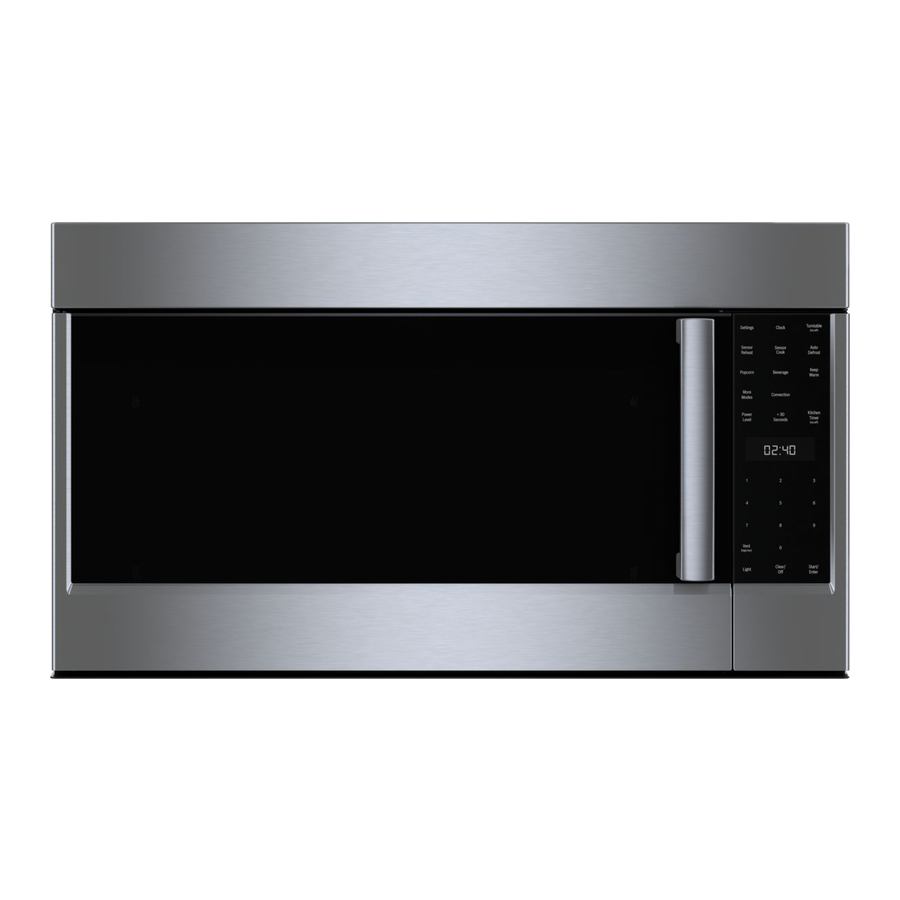IMPORTANT SAFETY INSTRUCTIONS
9
READ ALL INSTRUCTIONS BEFORE USING THE APPLIANCE
Cooking Items
Eggs: Do not cook or reheat whole eggs, with or without
shell. Steam buildup in whole eggs may cause them to
explode, and possibly damage the oven or cause injury.
Reheating sliced hard-boiled eggs and cooking
scrambled eggs is safe.
Popcorn: Use only popcorn in packages designed and
labeled for microwave use, or pop it in a microwave oven
corn popper. Follow popcorn manufacturers' directions
and use a brand suitable for the wattage of your oven.
Do not continue to heat after popping has stopped.
Popcorn will scorch or burn. Do not leave oven
unattended.
CAUTION
When using pre-packaged microwave popcorn, check
package weight before using the popcorn function. Set
the oven for the weight of the popcorn package. If these
instructions are not followed, popcorn may not pop
adequately or may ignite and cause fire.
Foods with nonporous skins: Potatoes, tomatoes, sweet
potatoes, apples, whole squash and sausages are
examples of foods with nonporous skins. These types of
foods must be pierced before cooking to prevent them
from exploding.
Baby food / Baby formula: Do not heat baby bottles or
food in microwave oven. The glass jar or the surface of
food may appear warm while the interior can burn the
infant's mouth and esophagus.
Deep fat frying: Do not deep fat fry in oven. Oil can be
heated beyond ideal temperatures very quickly in a
microwave oven. Temperatures can climb high enough
for the cooking oils to reach their respective flash points
and burst into flames. The heated oil may bubble and
spatter causing possible damage to the oven and
perhaps result in burns. Additionally, microwave–safe
utensils may not be able to withstand the temperature of
the hot oil, and could result in the utensil shattering, if it
contains a slight imperfection, scratch or chip.
Home Canning / Drying foods / Small quantities of
foods: Do not use microwave oven for home canning or
heating of any closed jar. Pressure will build up and the
jar may explode. In addition, the oven cannot maintain
the food at the proper canning temperature. Improperly
canned food may spoil and be dangerous to consume.
Small quantities of food or foods with low moisture
content can dry out, burn or catch on fire.
Do not dry meats, herbs, fruits or vegetables in your
oven.
Proper cooking depends on time set and weight of food.
If you use a smaller portion than recommended and
cook at the time for the recommended portion, fire could
result.
Browning dishes: Microwave browning dishes or grills
are designed for microwave cooking only. Preheating
times vary depending on the size of the browning dish
and food being cooked. Always follow instructions
provided by the browning dish or grill manufacturer. Do
not preheat browning dishes more than 6 minutes.
Oven roasting bags: If an oven bag is used for
microwave cooking, prepare according to package
directions. Do not use wire twist–ties to close bags,
instead use nylon ties, cotton string or a strip cut from
the open end of the bag. Make six ½" (12.7 mm) slits by
closure. Place oven cooking bag in a dish slightly larger
than the food being cooked.
Cooking Utensils
See also Microwave Utensil Guide.
Cooking utensils, the ceramic tray and racks get hot
during microwaving. Always use potholders when
removing items from the oven. Allow the ceramic tray
and the metal racks (if used) to cool before handling.
Do not use metal utensils, or dishes with metallic trim in
the oven.
When using aluminum foil in the oven, allow at least
1 inch (25 mm) of space between foil and interior oven
walls or door.
The ceramic tray and the metal racks (if used) will get hot
during cooking. The cooking container and the ceramic
tray can be hot even if the oven is cool.
Never use paper, plastic, or other combustible materials
that are not intended for cooking.
When cooking with paper, plastic, or other combustible
materials, follow manufacturer's recommendations on
product use. Do not use paper towels which contain
nylon or synthetic fibers. Heated synthetics could melt
and cause paper to ignite.
Do not heat sealed containers or plastic bags in oven.
Food or liquid could expand quickly and cause container
or bag to break. Pierce or open container or bag before
cooking.
Metal Tray Turntable
Do not operate the oven without the metal tray turntable
in place.
Verify that the metal tray turntable is properly positioned
and turning when the oven is in use. Improper cooking or
damage to the oven could result.
Only use the metal tray turntable designed for this oven.
Do not substitute any other tray.
Always replace the metal tray in its proper position.
Thermometers
Do not use regular cooking thermometers in oven. Most
cooking thermometers contain mercury and may cause
electrical arc, malfunction, or damage to the oven.
SAVE THESE INSTRUCTIONS.
7

